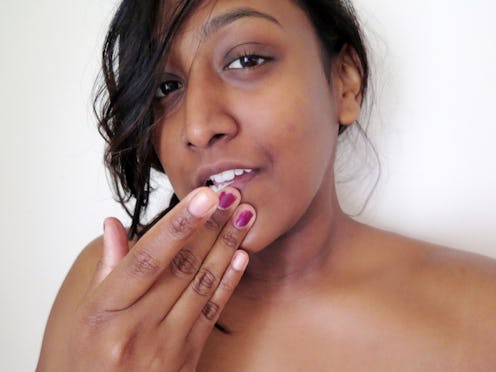Fashion
This Is What It's Like To Get A Chemical Peel

My journey into the world of chemical peels (and chemical peel before and after photos) all started with Nigel The Zit. Every month, like clockwork, I get a zit approximately the size of the African continent on my face. It usually goes away with traditional, over-the-counter zit-zapping remedies — but not this time. Nigel was massive, stubborn, and embedded in the sensitive skin right under my eye. I decided to visit my dermatologist, Dr. Komathy, at The Lifestyle Clinic in Singapore to get Nigel removed with the help of a cortisone shot. As it turned out, she decided I needed a chemical peel for acne this time around.
A cortisone shot is kinda like a last resort to getting rid of a zit that needs to disappear fast, or in my case, one that refuses to go away. Within 72 hours, Nigel had almost disappeared from my face, but unfortunately he left behind hyper pigmentation. I already have dark eye circles thanks to my deep set eyes and my lack of sleep, so another spot on my face wasn’t exactly something I welcomed with wide open arms. The doctor recommended I get the Obagi Blue Peel around my eyes to help treat what Nigel left behind.
Now, listen. I like to think I have a relatively higher threshold of pain. For example, I somehow managed to live through an entire week without painkillers when I first broke a toe while surfing (the island I was on didn't have cars or bikes — the local doctor came to me on a bicycle!). Well, I'm reevaluating my life after getting an Obagi Blue Peel. It is not a fun, relaxing facial. Let me break it down for you.
So, what is a peel?
The Obagi Blue Peel is an facial chemical peel procedure that is administered in a doctor's or aesthetician's office. Like all peels, a chemical solution is applied to the skin and allowed to soak in. Over the next 1 to 14 days, depending on how deeply the chemical penetrates the skin, the skin peels off. This procedure destroys parts of the skin in a controlled way to make way for new cells. Think of it like a snake shedding its skin for a fresher, prettier one. This procedure can be done on a concentrated area of your face, like I did with my eye area, or all over.
The Procedure
After my eye makeup was removed and I was lying flat, the chemical solution was applied on my eye area — first my under-eye, and then my lids.
And then the burning came.
It felt like I had rubbed ghost pepper in my eyes. It was searing hot, and, even though the solution was swiped off almost as quickly as it was applied, the burning persisted. The nurse who was assisting had to fan my face to cool it as the doctor washed off the solution. I started to tear too, but while I thought it was painful, it was a bearable pain. You can also choose to have numbing cream applied prior to the procedure, if you know you won't be up for the heat.
Here's what it looked like right after. The whitish patches are the peel formula seeped into my skin:
The Next Day
My skin began to peel over the course of the next few days. It's not a comfortable feeling, either. My eye area felt dry and tight, and the only thing I could do was continuously moisturize the area.
I look diseased. On Day 3, when I hadn't noticed any peeling, I called the clinic and was advised to hydrate the area to facilitate peeling. On top of the Obagi cream and the moisturiser I was given, I was advised to use a hydrating mask as well. I did, and I started flaking!
It's important not to pick at scabs or peeling skin. After a peel, the area on face tends to scab, but picking can increase the risk of an infection, skin discoloration, and scarring. Moisturizing and being even more diligent about sunscreen than usual are crazy important steps for healing correctly.
I was still going to work during my peeling period, even though I didn't have makeup on. I did have sunnies or glasses on most of the time so I don't scare people.
At The End Of The Week
I was taking showers multiple times a day during the peeling stage, which I believe helped my eye area hydrate more. When my skin first started peeling and I could see the skin underneath, I started freaking out because the new skin was pinkish and much lighter than the area around my eyes usually is. While I didn't pick at the scabs, my tossing and turning in bed must've helped facilitate the peeling too. Here's what my eyes look like on the 5th, and 6th morning when I woke up, as well as the slither of skin I woke up next to:
By day 9 post-peel, most, if not all, of my old skin have peeled off. It was itchy, the same kind of itch you get when you cut yourself and your skin is healing.
My new skin was still pinkish, but it gradually got to the color of my normal skin in a few days. I no longer had to slather under-eye concealer before I left for work. In fact, all I needed was moisturizer and sunscreen, some mascara and I was ready!
Would I do it again? In a heartbeat. Maybe this time, a full-face peel around Halloween.
Images: Faz Abdul Gaffa-Marsh